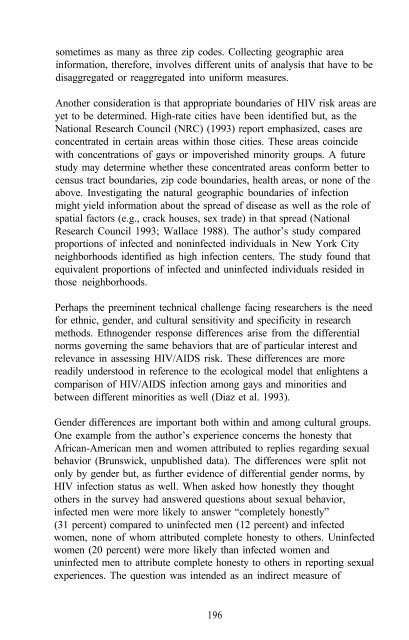The Context of HIV Risk Among Drug Users and Their Sexual Partners
The Context of HIV Risk Among Drug Users and Their Sexual Partners
The Context of HIV Risk Among Drug Users and Their Sexual Partners
You also want an ePaper? Increase the reach of your titles
YUMPU automatically turns print PDFs into web optimized ePapers that Google loves.
sometimes as many as three zip codes. Collecting geographic area<br />
information, therefore, involves different units <strong>of</strong> analysis that have to be<br />
disaggregated or reaggregated into uniform measures.<br />
Another consideration is that appropriate boundaries <strong>of</strong> <strong>HIV</strong> risk areas are<br />
yet to be determined. High-rate cities have been identified but, as the<br />
National Research Council (NRC) (1993) report emphasized, cases are<br />
concentrated in certain areas within those cities. <strong>The</strong>se areas coincide<br />
with concentrations <strong>of</strong> gays or impoverished minority groups. A future<br />
study may determine whether these concentrated areas conform better to<br />
census tract boundaries, zip code boundaries, health areas, or none <strong>of</strong> the<br />
above. Investigating the natural geographic boundaries <strong>of</strong> infection<br />
might yield information about the spread <strong>of</strong> disease as well as the role <strong>of</strong><br />
spatial factors (e.g., crack houses, sex trade) in that spread (National<br />
Research Council 1993; Wallace 1988). <strong>The</strong> author’s study compared<br />
proportions <strong>of</strong> infected <strong>and</strong> noninfected individuals in New York City<br />
neighborhoods identified as high infection centers. <strong>The</strong> study found that<br />
equivalent proportions <strong>of</strong> infected <strong>and</strong> uninfected individuals resided in<br />
those neighborhoods.<br />
Perhaps the preeminent technical challenge facing researchers is the need<br />
for ethnic, gender, <strong>and</strong> cultural sensitivity <strong>and</strong> specificity in research<br />
methods. Ethnogender response differences arise from the differential<br />
norms governing the same behaviors that are <strong>of</strong> particular interest <strong>and</strong><br />
relevance in assessing <strong>HIV</strong>/AIDS risk. <strong>The</strong>se differences are more<br />
readily understood in reference to the ecological model that enlightens a<br />
comparison <strong>of</strong> <strong>HIV</strong>/AIDS infection among gays <strong>and</strong> minorities <strong>and</strong><br />
between different minorities as well (Diaz et al. 1993).<br />
Gender differences are important both within <strong>and</strong> among cultural groups.<br />
One example from the author’s experience concerns the honesty that<br />
African-American men <strong>and</strong> women attributed to replies regarding sexual<br />
behavior (Brunswick, unpublished data). <strong>The</strong> differences were split not<br />
only by gender but, as further evidence <strong>of</strong> differential gender norms, by<br />
<strong>HIV</strong> infection status as well. When asked how honestly they thought<br />
others in the survey had answered questions about sexual behavior,<br />
infected men were more likely to answer “completely honestly”<br />
(31 percent) compared to uninfected men (12 percent) <strong>and</strong> infected<br />
women, none <strong>of</strong> whom attributed complete honesty to others. Uninfected<br />
women (20 percent) were more likely than infected women <strong>and</strong><br />
uninfected men to attribute complete honesty to others in reporting sexual<br />
experiences. <strong>The</strong> question was intended as an indirect measure <strong>of</strong><br />
196
















